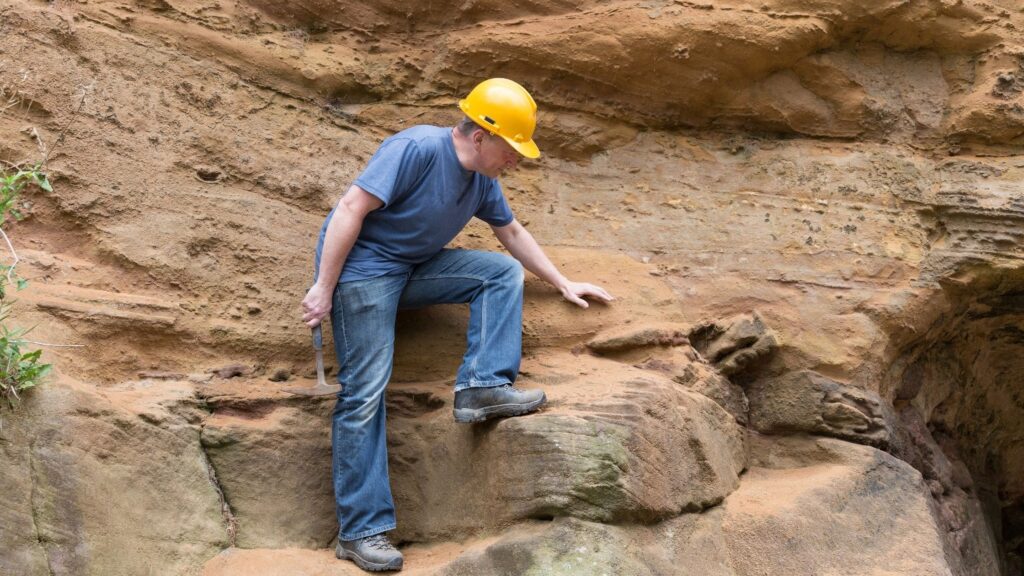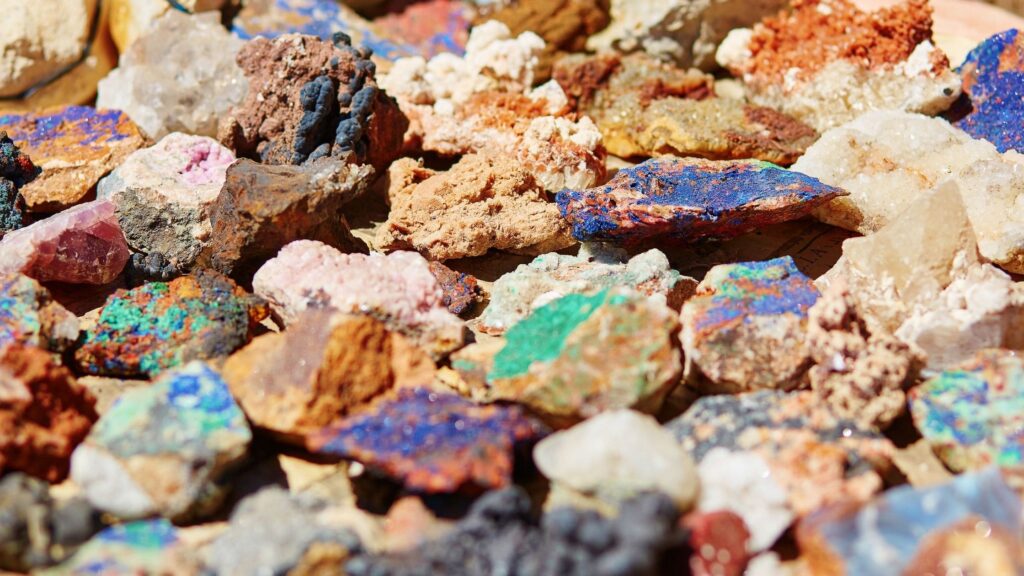In the past, oil was only obtained when it seeped into the earth surface.
However, technological advancement has made it possible to collect oil by drilling holes thousands of meters below the ground surface.
Do you wish to know how to find oil on your land? If so, this guide will provide insight into this. Now, let’s dive in!
How is oil formed and stored in the earth?
Oil is formed, deep in the earth, from the remains of diatoms that existed millions of years ago. The remains of these phytoplanktons sank to the bottom of the ocean and accumulated in large amounts in an oxygen-free medium. Over a long period, they became buried deeper while being exposed to a very long chemical conversion process by bacterial decomposition. Kerogen represents a product of this anaerobic decomposition of organic matter. This organic material slowly generates oil and gas under high temperature and pressure. Between 60°C to 120°C, oil is mainly generated.
Oil is usually stored in storage tanks, which could have capacities as high as 390,000 barrels. These tanks can store crude oil, finished products, and chemicals. In order to prevent water or soil pollution, containment areas must be built to hold dedicated capacities in case of a rupture. Containment systems at refineries are designed to redirect rainwater runoff to effluent treatment facilities in the refinery. This is to make sure that no traces of chemicals can enter local water.
How to find if there is oil on your land?
It might prove challenging trying to know how to find oil on your land. Instead of making use of drills to search for oil presence on random spots, you can employ the services of specialists such as geophysicists and geologists to determine the presence of oil. They adopt the use of different resources to identify the presence of oil on your land surface.
Geologists
You can reach out to geologists. What they do is examine rock types and determine the presence of underground hydrocarbons. When geologists investigate earth resources, they do not just examine the water and metals, they also explore minerals, oil, and natural gas, as well as techniques that can help extract them. To determine the possibility of finding oil in your property, a geologist can help you research the area while performing a field inspection.
Geophysicists
You can also call upon the service of a team of geophysicists to find oil on your property. They focus on studying the physical properties of the subsoil. With this, it becomes easy to examine the likelihood of the existence of oil on your property. They can adopt the use of top equipment to take measurements and record data. Signals are sent below the surface of the land through vibrations. With the use of geophones, the reflected waves are received while data is collected and stored for further analysis.
Wildcats – small exploration companies
Wildcat drillers specialize in exploratory drilling, which involves drilling for oil in areas that have no proven record or have been fully exhausted as a site of oil output. For this reason, it is essential for the drilling crew to be skilled and experienced while being acquainted with the several oil well parameters that can give them vital information. This is due to the high level of uncertainty that is associated with wildcat drilling.
Usually, highly successful energy companies have high rates of oil drilling success, regardless of whether the area is well-known for production or not. You can hire the services of a wildcat driller to help you find oil on your property.
There are certain signs to watch out for, which indicate the presence of oil on your land. Some of these include:
Surface Indications
The most likely surface indication to pay attention to is underground rock formations. In many cases, subsurface folds and faults in rock formations are seen repeatedly in the surface structures and features. Take, for instance, faulting in rock formations that surround any underground salt domes can result in the accumulation of oil and gas.
Oil has already seeped to the surface
Another sign to look out for is an underground oil that has seeped to the surface of the land. Oil used to be collected when it seeped into the earth’s surface before various drilling techniques were invented.
Geological Correlation
This involves the correlations of oils between source rocks and to one another. This is an essential component of determining the petroleum system of a basin. Oil to oil correlations is concerned with determining the possibility of oil being generated from the same source. On the other hand, oil – source correlations involve attempts that are directed towards figuring out the specific source facies that brought about an oil.
Correlations studies are aimed to set up a genetic relationship between geological samples instead of just comparing the general physical and chemical properties. Since secondary processes – including migration, thermal maturation, and biodegradation – can change the original composition of the oil.
Gravitational field variations
The earth’s gravity is fairly constant. Yet, there is a slight variation anywhere there is a dense rock formation lying close to the surface. In this case, gravitational force surges over the tops of anticlinal folds while decreasing over the tops of salt domes.
A gravimeter is a sensitive instrument that can help measure a very slight change in gravitational force. All measurements are taken on a grid over and all results are interpreted to show the presence of oil or gas formations.
The magnetic properties of a type of rock can help in accomplishing magnetic surveys. These rocks affect the magnetic field of the earth when they are close to the surface. In this case, sensitive instruments are also used to map any deviation over a large area. Aircraft are also used to carry out these surveys over larger land areas.
Magnetotellurics is a method that takes the measurement of the earth’s electromagnetic field. There are differences in the electrical resistivities of rock formations. This causes variations that can be studied and interpreted to show the geological characteristics below the earth’s surface.
Magnetotellurics represents a cost-effective means of identifying the presence of oil before more time- and energy-intensive techniques and seismic surveys are adopted. This method senses whatever lies within the stratigraphic layers of the earth. Take, for instance, porous rocks are generally conductive since there is brine and saltwater contained in them. On the other hand, crystalline rocks are usually resistive to electromagnetic waves. These salt domes are some of the anomalies that geologists look for since they represent stratigraphy traps for oil.
Sound wave velocities
Sound waves travel at different speeds in different mediums. However, within a medium, these speeds are fairly constant. Sound is created by airguns and the images of the shear waves in the water and subsurface are produced by the sonic returns.
The sound wave that returns to the surface through the sub-seafloor strata is detected by hydrophone streamers. These reflected sound waves are recorded for the strength of the sound waves. Processing all successful seismic waves needs a correct reading of the sound waves that are returning. This is because sound travels through different mediums – liquid, solid, and gaseous mediums – at varying speeds.
What do you do if you find oil on your land?
Discovering minerals (including oil and natural gas) under the surface of your property may be very good news since oil represents a great asset, which can offer financial security. Yet, making money from it may not be a guarantee since the oil, as well as other resources beneath the ground surface, might not belong to you. This is where the concept of mineral rights comes in!
Mineral rights ensure that you have an ownership right to any underground resources, including oil. If you own land, what you have is surface property rights. This implies that you can grow plants and raise livestock on the land. You can also build whatever you want on your property. Simply put, a property rights owner cannot access the resources beneath the land surface.
To own oil, natural gas, or any other mineral resources on your land, you need to have mineral rights besides the property rights you may own. Mineral rights owner do not need the permission of a property rights owner to access the oil beneath the property. The government of some few countries has the right over all mineral resources – including oil – in these countries. In the United States, it is possible for private individuals to own mineral rights. Simply put, owning a mineral might mean that you have rights over the oil in the land.
Now that you have mineral rights, what is the next step?
Owning the mineral right implies that you own the oil. Yet, drilling the oil is very expensive. Do you have enough capital to drill the oil? If not, you can sign a lease agreement or sell the mineral rights to anyone – individuals or companies – that have the money or resources to exploit the oil.
To search for mineral rights, you might be required to look beyond the present surface owner to figure out if any records of mineral rights exist. As explained above, mineral rights might not be owned by the property owner. Besides this, it is worth stressing that new owners must be informed that these rights cannot be transferred automatically through surface/property ownership.
If you own mineral rights, how do you find the ownership?
Doing this might be challenging. However, finding out who owns the mineral rights to your land might bring forth rewarding results. It is often best to start with the property deed when looking for mineral owners. A property deed will offer all information that is required to start the search. The type of deed, transfer details, seller’s information, and property description represent some of the important information you must gather.
How to search for mineral rights records?
Besides looking at who is the current owner of the land, you should probe further when you are searching for records on mineral rights. Below are some of the things you have to examine:
County Records and Tax Assessor’s Office and Documents
You can search for a title deed at the county records office. This will help you figure out the title deed owner history. Once you peruse this history, you can determine if the property was owned by an oil and gas company at any time. Through this, you can also get a direction to begin your mineral rights search.
Royalty deeds
Besides mineral rights deeds, which ensure that owners can explore and carry out drilling activities, there are also royalty deeds. These give holders the right to receive a royalty whenever any oil and gas company exploits the minerals. This implies that while the majority of the work is done by mineral rights owners, holders of royalty deeds can enjoy financial benefits. The production of minerals being set up can also provide oil and gas royalties.
Another way to search for mineral rights is to employ a title company to conduct mineral rights research on the land. Regardless of how expensive this search might be, they are better qualified to carry out this search with respect to the mineral rights.
Mineral rights broker
Mineral rights brokers are professionals that help you get the best price for your mineral rights. Getting buyers to compete for mineral rights (for sale) can be better accomplished with the help of https://www.pheasantenergy.com/. Through pheasant energy, brokers can get a high rate of opportunities, as well as a reputable history of quicker transactions.
Conclusion
From the 16th century through to the 19th century, there was a reliance on whale oil (or train oil) as a primary source of lamp fuel.
However, as mankind evolved through science and technological advancement, getting oil from the ground became possible.
As stated above, there are several methods that can help in extracting oil – as well as natural gas – from beneath the earth surface. This represents great revenue for companies and nations.
However, if you happen to find out – through any of the aforementioned methods – that your property has oil, having mineral rights – alongside property rights – ownership is the only way to access the oil.









